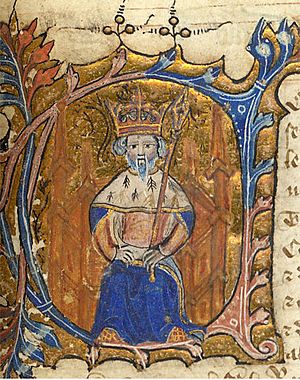Alice Perrers facts for kids
Quick facts for kids
Alice Perrers
|
|
|---|---|

Painting by Ford Madox Brown
|
|
| Born |
Alice Salisbury(?)
Alice Perrers of Holt (?) circa 1348 |
| Died | 1400/1401 |
| Resting place | Church of St Laurence, Upminster, England |
| Other names | Alice de Windsor |
| Known for | Mistress of Edward III of England |
| Spouse(s) | Janyn Perrers (m. 1360; his death in 1364) Sir William de Windsor (m. 1375; his death in 1389) |
| Partner(s) | King Edward III of England |
| Children | 3 including Sir John de Southeray |
Alice Perrers, also known as Alice de Windsor (circa 1348 –1400/1401) was an English royal mistress, lover of Edward III, King of England. As a result of his patronage, she became the wealthiest and most influential woman in the country. She was widely despised and accused of taking advantage of the old king.
Contents
Life
Early life
Alice was born around 1348. No birth record remains, but it seems that Perrers was the surname of her first husband. Her ancestry has been the topic of much speculation, which is detailed below. Around 1360, at the age of 12, she married Janyn Perrers, a jeweler who died around 1364.
Life at the royal court
Perrers became a part of the household of Queen Philippa (1310/1315–1369) as a domicella ("damsel") before 1359. She became the mistress of the king, Edward III (1312–1377) around 1366, when she was around 18 years old and the king 55. During the queen's life, they had three children together. Three years after their relationship started, the queen died, which devastated the king, causing him to lean more on Perrers. This resulted in her receiving more, mostly negative, attention from the court.
The king showered Perrers with gifts, quickly making her an extremely wealthy woman. She amassed a fortune of more than £20,000, which would be worth around £6,000,000 as of 2016. She was paraded around London in golden garments as the "Lady of the Sun" at the king's command, causing a wave of public criticism.
Perrer's power further grew between 1370 and 1376. She reportedly provoked fear, and no one dared to sue her. She was seen as an ambitious, calculating, cold-hearted opportunist who manipulated the elderly king. Towards the end of Edward III's life, Perrers was even accused of making his life miserable.
As the king's health was ailing, Perrers contracted a secret marriage in November 1375, at the age of 27, with 53-year-old Sir William de Windsor, Baron Windsor (circa 1325–1384) to ensure her safety and livelihood after Edward's death. He was the king's lieutenant in Ireland. De Windsor spent long periods of time away from England, thus making it less probable that the king would discover the marriage. The couple remained together until the death of the husband on 15 September 1384, but had no children.
Exile
In 1376, an ordinance aimed specifically at Perrers set penalties for women who practiced "maintenance", interfering in the due process of the law. A contemporary description of the ordinance is as follows:
Because a complaint was made to the king that some women have pursued various business and disputes in the king's courts by way of maintenance, bribing and influencing the parties, which thing displeases the king; the king forbids any woman to do it, and especially Alice Perrers, on penalty of whatever the said Perrers can forfeit and of being banished from the realm.
Perrers was tried for corruption and subsequently exiled from England by the Good Parliament, her lands forfeit. She was later able to return and regain some of her lands.
Death
Perrers died during the winter of 1400/1401, aged around 52, and was buried in the Church of St Laurence in Upminster.
Lands
At the height of her power, Perrers possessed 56 manors, castles and town houses in over 25 counties of England, only 15 of which were gifts from the king. These properties included Playford Hall in Suffolk, and the manor of Gaynes in Upminster, Essex. When property disputes arose with the abbot of St. Albans in 1374, Perrers, with the King's authority behind her, sat in the court to intimidate the judges and ensured that the abbot abandoned his claim.
Influence on literature
Perrers is thought to have served as the prototype for Geoffrey Chaucer' Wife of Bath in The Canterbury Tales. She was also a major patron of Chaucer.Her influence on literature may also have extended to William Langland's Lady Mede in Piers Plowman.
Issue
Perrers had three illegitimate children with King Edward III during the lifetime of Queen Philippa, thus between 1366 (when their relationship started) and 1369 (the queen's death):
- Sir John de Southeray (circa 1364 – 1383), who married Maud Percy, daughter of Henry Percy, 3rd Baron Percy and had no issue;
- Jane, (born circa 1365), who married Richard Northland;
- Joan (circa 1366 – before January 1431), who married Robert Skerne, a lawyer and member of parliament.
From her marriage to William de Windsor, she had no children.
In fiction
Candace Robb features Alice Perrers in her Medieval Mysteries series and Perrers is the main protagonist in Robb's The King's Mistress written as Emma Campion. She appears in Anya Seton's 1954 novel Katherine. Alice Perrers is the main character in Vanora Bennett's 2010 novel The People's Queen. She is a character in Jean Plaidy's Vow on the Heron. She is portrayed in Rebecca Gablé's Das Lächeln der Fortuna, a historical novel in the German language about the time-period. She is the protagonist of the 2012 novel The King's Concubine by Anne O'Brien. She also appears in The Traitor's Noose, the fourth novel in the Lions and Lilies series by Catherine A. Wilson and Catherine T. Wilson.




